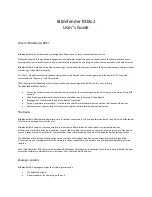
default precedence which is 0.
There are 8 Possible Precedence Levels
Eight precedences exist which are numbered from 0 to 7. Precedence 0 is the least important (lowest
priority) precedence and 7 is the most important (highest priority) precedence. A precedence can be
viewed as a separate traffic queue; traffic in precedence 2 will be forwarded before traffic in
precedence 0, precedence 4 forwarded before 2.
Figure 10.4. The Eight Pipe Precedences
Precedence Priority is Relative
The priority of a precedence comes from the fact that it is either higher or lower than another
precedence and not from the number itself. For example, if two precedences are used in a traffic
shaping scenario, choosing precedences 4 and 6 instead of 0 and 3 will makes no difference to the
end result.
Allocating Precedence to Traffic
The way precedence is assigned to traffic is specified in the triggering pipe rule and can be done in
one of three ways:
•
Use the precedence of the first pipe
Each pipe has a Default Precedence and packets take the default precedence of the first pipe
they pass through.
•
Use a fixed precedence
The triggering pipe rule explicitly allocates a fixed precedence.
•
Use the DSCP bits
Take the precedence from the DSCP bits in the packet. DSCP is a subset of the Diffserv
architecture where the Type of Service (ToS) bits are included in the IP packet header.
Specifying Precedences Within Pipes
When a pipe is configured, a Default Precedence, a Minimum Precedence and a Maximum
Precedence can be specified. The default precedences are:
•
Minimum Precedence: 0
10.1.6. Precedences
Chapter 10. Traffic Management
458
Summary of Contents for NetDefend DFL-260E
Page 27: ...1 3 NetDefendOS State Engine Packet Flow Chapter 1 NetDefendOS Overview 27...
Page 79: ...2 7 3 Restore to Factory Defaults Chapter 2 Management and Maintenance 79...
Page 146: ...3 9 DNS Chapter 3 Fundamentals 146...
Page 227: ...4 7 5 Advanced Settings for Transparent Mode Chapter 4 Routing 227...
Page 241: ...5 4 IP Pools Chapter 5 DHCP Services 241...
Page 339: ...6 7 Blacklisting Hosts and Networks Chapter 6 Security Mechanisms 339...
Page 360: ...7 4 7 SAT and FwdFast Rules Chapter 7 Address Translation 360...
Page 382: ...8 3 Customizing HTML Pages Chapter 8 User Authentication 382...
Page 386: ...The TLS ALG 9 1 5 The TLS Alternative for VPN Chapter 9 VPN 386...
Page 439: ...Figure 9 3 PPTP Client Usage 9 5 4 PPTP L2TP Clients Chapter 9 VPN 439...
Page 450: ...9 7 6 Specific Symptoms Chapter 9 VPN 450...
Page 488: ...10 4 6 Setting Up SLB_SAT Rules Chapter 10 Traffic Management 488...
Page 503: ...11 6 HA Advanced Settings Chapter 11 High Availability 503...
Page 510: ...12 3 5 Limitations Chapter 12 ZoneDefense 510...
Page 533: ...13 9 Miscellaneous Settings Chapter 13 Advanced Settings 533...












































